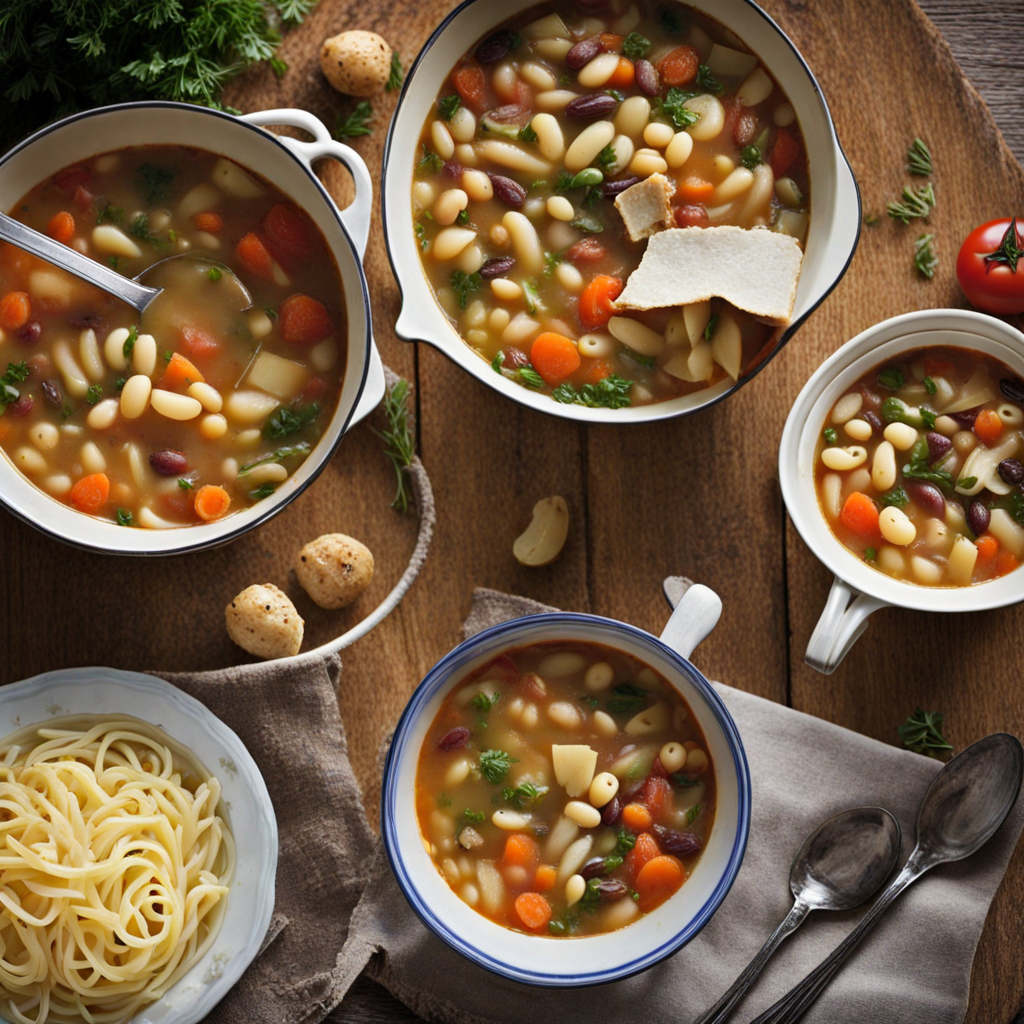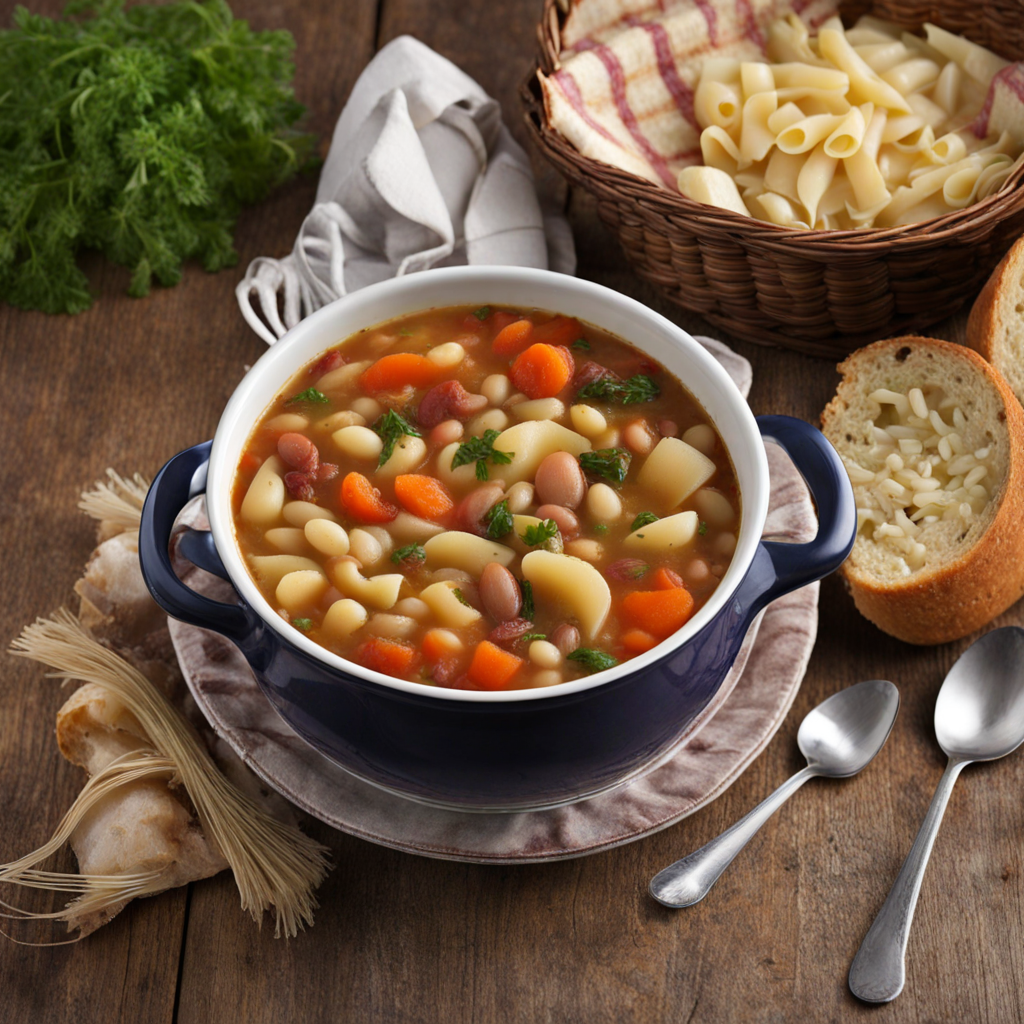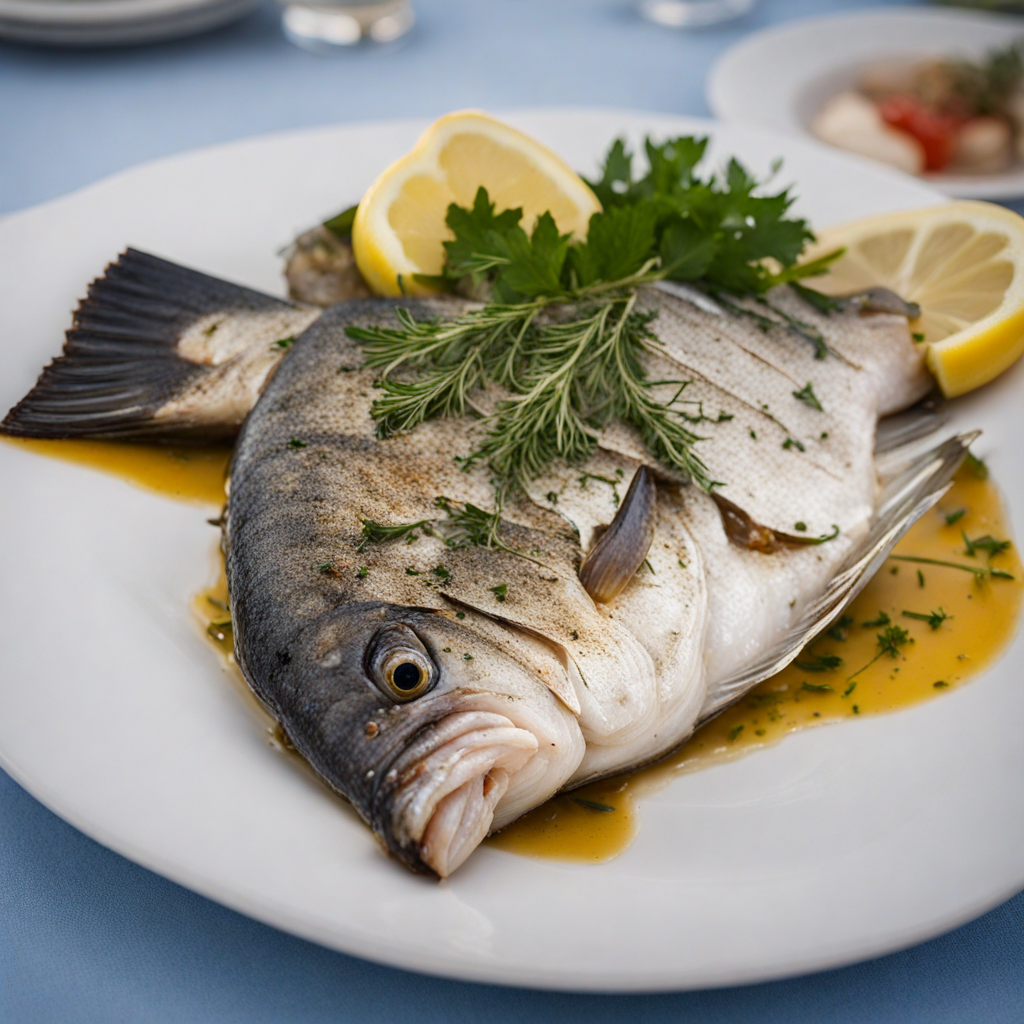Slovenian Minestrone
Slovenian Minestrone is a hearty and comforting soup that reflects the rich culinary traditions of Slovenia, combining fresh, local ingredients with rustic flavors. This dish typically features a medley of seasonal vegetables such as carrots, potatoes, zucchini, and green beans, all simmered together to create a vibrant and colorful base. The addition of leafy greens like kale or Swiss chard adds a nutritious touch, while herbs such as parsley and dill enhance the aroma and depth of flavor. What sets Slovenian Minestrone apart from other minestrone variations is its unique incorporation of local grains or pasta, which not only provides texture but also makes the dish more filling and satisfying. The broth is often enriched with a rich vegetable stock, sometimes flavored with a splash of white wine or a hint of smoked paprika, giving it a gentle warmth and complexity. Traditionally, Slovenian Minestrone may include beans, which contribute to the heartiness and protein content of the dish. The beans are typically cooked until tender, allowing them to absorb the flavors of the broth, resulting in a wholesome meal that is both nourishing and delicious. The soup is usually finished with a drizzle of high-quality olive oil or a sprinkle of grated cheese, adding a touch of richness and elevating the overall experience. Served hot, Slovenian Minestrone is perfect for sharing with family and friends, making it an ideal centerpiece for gatherings. It can be accompanied by crusty bread or a side of polenta, further enhancing the comforting experience of this rustic dish. Whether enjoyed on a chilly day or as a light summer meal, Slovenian Minestrone embodies the essence of Slovenian cuisine—simple, hearty, and deeply satisfying, inviting you to explore the flavors of this beautiful country.
How It Became This Dish
Slovenska Mineštra: A Culinary Legacy of Slovenia Slovenska mineštra, a traditional Slovenian dish, represents not just a meal but a mosaic of the country’s rich cultural heritage, agricultural practices, and communal values. The term “mineštra” is derived from the Italian word for soup or stew, reflecting Slovenia’s historical connections to its neighbors and the broader Mediterranean culinary traditions. This dish has evolved over centuries, becoming a staple in Slovenian kitchens and embodying the essence of local ingredients and communal cooking. Origins and Historical Context The roots of Slovenska mineštra can be traced back to the early agricultural communities of Slovenia. As far back as the Middle Ages, the region was characterized by a diverse agricultural landscape with a variety of vegetables, legumes, and grains. The dish is believed to have originated from the necessity of using available ingredients to create a nourishing meal. The Slovenian landscape, dotted with fields, gardens, and local markets, provided an abundance of fresh produce, which became the backbone of this hearty stew. Historically, mineštra was a common food among farmers and working-class families. It was practical; the ingredients could be varied depending on the season, and leftovers from previous meals could easily be incorporated. This adaptability made it a beloved dish, as families could tailor it to their tastes and dietary needs. The dish typically includes a combination of vegetables such as potatoes, carrots, beans, and cabbage, and is often enriched with grains like barley or rice, making it a complete meal. Cultural Significance Slovenska mineštra is more than just a dish; it is a cultural symbol of Slovenian identity. It embodies the values of hospitality and sharing, which are deeply rooted in Slovenian culture. Traditionally, it is prepared in large quantities, making it perfect for gatherings and communal meals. Families often gather to share a pot of mineštra, reinforcing social bonds and fostering a sense of belonging. In Slovenia, food has a unique way of connecting people to their history and to each other. Mineštra is often served during significant occasions, such as family celebrations, holidays, and community festivals. It represents comfort and warmth, evoking feelings of nostalgia and home. The dish is especially popular during the cold winter months, providing sustenance and warmth to those who partake in it. Development Over Time As Slovenia underwent various political and social changes, so did its culinary landscape. The Austro-Hungarian Empire, which included Slovenia, introduced new ingredients and cooking techniques, influencing traditional recipes. This cross-cultural exchange enriched Slovenska mineštra, allowing for the incorporation of spices and flavors from diverse culinary traditions. In the 20th century, the rise of globalization began to impact Slovenian cuisine. While this posed challenges to traditional cooking practices, it also encouraged the revival of heritage recipes. Slovenska mineštra, with its deep roots in local culture, found a new appreciation among both locals and visitors. Chefs began to experiment with the dish, incorporating modern culinary trends while staying true to its traditional essence. Today, Slovenska mineštra is celebrated not only in homes but also in restaurants across Slovenia. Chefs take pride in using locally sourced, organic ingredients, emphasizing sustainability and the farm-to-table movement. This shift reflects a growing awareness of the importance of preserving culinary heritage while adapting to modern tastes and dietary preferences. Variants of the dish have emerged, including vegetarian and vegan versions, which cater to a broader audience while maintaining the spirit of the original recipe. Ingredients and Preparation The beauty of Slovenska mineštra lies in its flexibility and the creativity of the cook. While traditional recipes vary by region and family, the core ingredients remain consistent. Common vegetables include potatoes, carrots, celery, and cabbage, while legumes such as beans or peas add protein and substance. Grains like barley or rice can also be included, making the dish hearty and filling. A typical preparation involves sautéing onions and garlic to form the base of flavor, followed by the addition of chopped vegetables and legumes. Water or vegetable broth is then added, and the mixture is allowed to simmer until the ingredients are tender and the flavors meld together. Seasoning with salt, pepper, and herbs—such as parsley—enhances the dish, while a drizzle of olive oil or a splash of vinegar before serving adds a finishing touch. Modern Interpretations In recent years, Slovenska mineštra has experienced a renaissance, with chefs and home cooks alike embracing the dish for its historical significance and adaptability. Food festivals across Slovenia often feature competitions where participants showcase their unique takes on the classic recipe, celebrating regional variations and personal twists. This has invigorated interest in traditional Slovenian cuisine and inspired a new generation to reconnect with their culinary heritage. Culinary tourism has also played a role in the revitalization of Slovenska mineštra. Visitors to Slovenia often seek authentic experiences that highlight local flavors and traditions. Cooking classes that focus on traditional dishes, including mineštra, have become popular, allowing tourists to immerse themselves in Slovenian culture while learning the art of preparing this beloved stew. Conclusion Slovenska mineštra is more than just a dish; it is a testament to the resilience and creativity of the Slovenian people. Rooted in agricultural traditions, it has evolved over centuries, adapting to cultural changes while maintaining its core values of community, hospitality, and sustainability. As Slovenia continues to embrace its culinary heritage, Slovenska mineštra stands as a symbol of national pride and cultural identity. It invites everyone to share in the warmth of a home-cooked meal, fostering connections across generations and borders. Through each bowl of mineštra enjoyed, one can taste the history and heart of Slovenia, a nation that celebrates its past while looking forward to the future.
You may like
Discover local flavors from Slovenia






